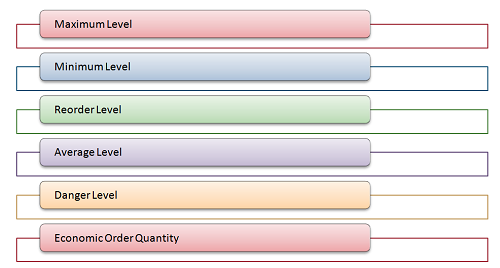Material Procurement – Inventory Levels & EOQ
An important function of Stores is to requisition materials for replenishment. The following tools help Stores to maintain required inventory and to guide on reorder quantity:

Let us discuss each of the above in detail:
Maximum Level
a. It is the upper limit beyond which the quantity of any item is not normally allowed to rise
b. The objective of fixing this level is to avoid overstocking so that the working capital is not unnecessarily blocked
c. The level is fixed after taking into consideration the rate of consumption, storage space available, lead time for delivery, nature of material, working capital required, inventory carrying cost, market trends, government restrictions, economic order quantity etc
d. It is computed using the formula
MxL = RL + RQ – (MnC x MnRP)
Where,
MxL = Maximum level
RL = Reorder level
RQ = Reorder quantity
MnC = Minimum consumption
MnRP = Minimum reorder period
Minimum Level
a. It is the lower limit below which the stock of any item should not normally be allowed to fall
b. It is also known as safety/buffer stock and is fixed with the objective of avoiding shortage of materials, thus helping in protecting against stock out
c. Factors which are considered while fixing this level are average rate of consumption, lead time required for replenishment etc
d. It is calculated using the formula
MnL = RL – (AC x ARP)
Where,
MnL = Minimum level
RL = Reorder level
AC = Average consumption
ARP = Average reorder period
Reorder Level
a. It is fixed between the minimum and maximum levels
b. When the stock level reaches this point, action is required to be initiated for purchase of material
c. This level is slightly more than minimum level and helps to guard against abnormal usage, abnormal delay in supply etc
d. It is computed using the formula
RL = MxC x MxRP
Where,
MxC = Maximum consumption
MxRP = Maximum reorder period
Average Level
a. It is the average of maximum and minimum level
b. It is computed using the formula
AL = (MxL + MnL)/2 or
AL = MnL + ½ RQ
Where,
AL = Average level
MxL = Maximum level
MnL = Minimum level
RQ = Reorder quantity
Illustration 1: From the following data, calculate reorder level, minimum level, maximum level, average stock level:
|
Particulars |
Item1 |
|
Maximum consumption per week |
75 units |
|
Average consumption per week |
50 units |
|
Minimum consumption per week |
25 units |
|
Reorder period |
4-6 weeks |
|
Reorder quantity |
400 units |
Solution:
|
Reorder level |
MxC x MxRP |
75 x 6 |
450 units |
|
Minimum level |
RL – (AC x ARP) |
450 – (50 x 5) |
200 units |
|
Maximum level |
RL + RQ – (MnC x MnRP) |
450 + 400 – (25 x 4) |
750 units |
|
Average level |
(MxL + MnL)/2 |
(750 + 200)/2 |
475 units |
Danger Level
a. It is fixed below the minimum level and normal stock should not fall below the minimum level
b. If the stock levels reaches danger level, urgent action to be taken to replenish stock to prevent stock out
c. It is computed using the formula
DL = MnC x ERP
Where,
DL = Danger level
MnC = Minimum consumption
ERP = Emergency reorder period
Economic Order Quantity
a. It helps to ascertain the quantity to be purchased of a particular material
b. It is the most desirable quantity to be ordered at which both ordering and carrying costs will be minimum
c. Ordering cost is the cost of placing a purchase order which also includes costs like handling/transportation costs, stationery costs, costs incurred for inviting quotations/tenders etc. More the frequency of order, more is the ordering cost
d. Carrying cost is the inventory carrying cost like warehouse charges, insurance, lighting, losses due to handling, spoilage, breakage etc and also the amount of interest lost due to investment in inventory. Carrying cost increases with the increase in the quantity of the material
e. EOQ is computed using the formula
EOQ = √(2ab/cs)
Where,
a = Annual consumption in units
b = Buying cost per order
c = Cost per unit
s = Cost of carrying inventory
Illustration 2: From the following data, compute economic order quantity:
Annual consumption = 20,000 units
Buying cost per order = Rs.10
Cost per unit = Rs.100
Cost of carrying inventory = 10% of cost
Solution:
Given,
a = 20,000
b = 10
c = 100
s = 10 (10% of c)
EOQ = √(2ab/cs) = √[(2 x 20000 x 10)/10] = 200 units







 CAclubindia
CAclubindia

